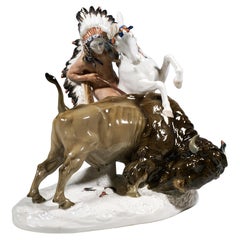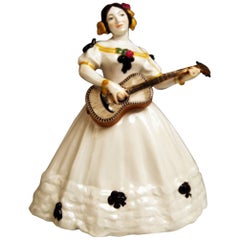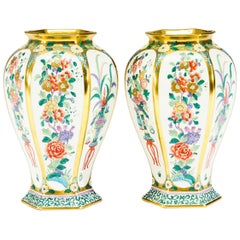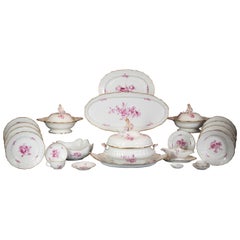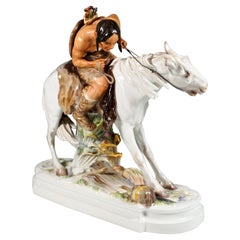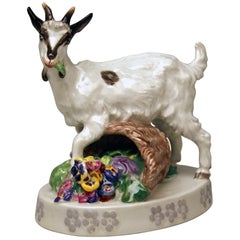Erich Hoesel Porcelain
1869-1951
Erich Hoesel was, since 1904, professor and leader of the Meissen Modelling Department till 1907 and the headmaster of the Meissen Modelling Department from 1912–29 when he retired.
to
2
2
1
1
1
2
2
2
2
2
2
2
2
2
1
341
225
166
143
Creator: Erich Hoesel
Meissen Art Nouveau Porcelain Group 'Indian Haunting A Buffalo', Hoesel, Germany
By Erich Hoesel, Meissen Porcelain
Located in Vienna, AT
Exquisite Large Meissen Art Nouveau Porcelain Group:
Representation of a mounted warrior with a painted face, wearing only a small loincloth and moccasins on his feet, and crowned wi...
Category
1930s German Art Nouveau Vintage Erich Hoesel Porcelain
Materials
Porcelain
Meissen Lady Lute Player Kate Hyan by Hoesel Erich V 143 Made circa 1912
By Erich Hoesel
Located in Vienna, AT
Meissen rarest figurine: female lute player (= Kate Hyan)
Measures / dimensions:
height: 10.23 inches
width: 8.26 inches
depth: 6.10 inches
Manufactory: Meissen
Hallmarke...
Category
Early 20th Century German Art Nouveau Erich Hoesel Porcelain
Materials
Porcelain
Related Items
Pair of Pickard Hand Painted Artist Signed Japonesque Vases, circa1912
By Pickard
Located in Great Barrington, MA
This pair of porcelain vases were custom order and uniquely studio painted as described on the base: "Decorated specially for Mrs. AA Carroll by Dizewiecki of the Pickard Studios, Ravenswood Chicago 1912".
The rare hexagonal shape is decorated in a Japonsque motif in vibrant polychrome enamels all highlighted in gold. Standing almost 12" tall, these are perfect as mantel (fireplace) vases, on a sideboard and of course filled with your favorite flowers!
"The Pickard China...
Category
1910s American Anglo-Japanese Vintage Erich Hoesel Porcelain
Materials
Porcelain
$4,200 / set
H 11.75 in Dm 7 in
Large German Porcelain Dinner Service, Meissen, circa 1875
Located in New York, NY
Delicately painted in German taste with rose camaieu flowers, the cavetto with spiral molding insterspersed with flowers, and the border with variations of basket weaving. Covered tureen and stand, pair of entree dishes, bowl, sauceboat, fish platter, meat platter, 12 dinner plates, 12 soup bowls, 12 coffee cup and saucers, 12 demi tasse cup and saucers...
Category
1870s German Antique Erich Hoesel Porcelain
Materials
Porcelain
Pair of Antique Porcelain Sconces by Meissen
By Meissen Porcelain
Located in London, GB
Pair of antique porcelain sconces by Meissen
German, late 19th Century
Measures: Height 57cm, width 38cm, depth 10cm
This fine pair of Ge...
Category
Late 19th Century German Rococo Antique Erich Hoesel Porcelain
Materials
Porcelain
Meissen, Blue Onion Oval Dish in Porcelain, circa 1900
Located in København, Copenhagen
Meissen, blue onion oval dish in porcelain.
circa. 1900.
Fourth factory quality.
Perfect condition.
Marked.
Dimensions: L 35,8 x D 26,3 x H 5,5 cm.
Category
Early 1900s German Antique Erich Hoesel Porcelain
Materials
Porcelain
Meissen porcelain cup and saucer, Germany, circa 1720-1730
Located in Vicenza, IT
Elegant cup and saucer made of Meissen porcelain, entirely hand-painted with vivid genre scenes and river landscapes enlivened by figures, architecture and boats, inspired by Dutch m...
Category
1730s German Rococo Antique Erich Hoesel Porcelain
Materials
Porcelain
18th Century Meissen Figurine of a Lady
By Meissen Porcelain
Located in Basildon, GB
A good 18th Century Meissen Figurine of a Lady, circa 1740, modelled by Peter Reinecke wearing a hat with a ribbon, floral dress and holding a bouquet of flowers and standing on a fl...
Category
1740s German Rococo Antique Erich Hoesel Porcelain
Materials
Porcelain
Antique Meissen Porcelain Figurine of Cupid Holding an Arrow & Flaming Heart
By Meissen Porcelain
Located in Hamilton, Ontario
This antique figurine was made by the renowned Meissen factory of Germany is approximately 1850 in the period Dresden style. The figurine is done in early paste porcelain and depicts a cherub, or Cupid seated on a stump, holding an arrow with an outstretched hand, and cradling a flaming heart...
Category
Mid-19th Century German Romantic Antique Erich Hoesel Porcelain
Materials
Porcelain
$799
H 7.75 in Dm 3.75 in
Important Meissen Porcelain Groups of Caparisoned Elephants and Soldiers
By Meissen Porcelain
Located in New York, NY
An important pair of Meissen Porcelain Groups depicting "Alexander The Great Concurring India". Modeled with Alexander the great's three warriors/soldiers riding on caparisoned eleph...
Category
1880s German Rococo Antique Erich Hoesel Porcelain
Materials
Porcelain
$95,800
H 15.5 in W 13.5 in D 6.5 in
Limoges porcelain plate hand-painted roses circa 1903-1912
By Limoges
Located in Paris, FR
An elegant Limoges porcelain plate, beautifully executed by the esteemed Paroutaud Frères (B & P), operating in Limoges, France, during the early 20th century. This plate exemplifies...
Category
19th Century French Antique Erich Hoesel Porcelain
Materials
Porcelain
German Meissen 'Marcolini' Porcelain Tea and Coffee Service, circa 1790
By Meissen Porcelain
Located in New York, NY
Comprising coffee pot, tea pot, covered cream jug, covered sugar, ten tea cups, six coffee cups, 16 saucers.
Category
1790s German Antique Erich Hoesel Porcelain
Materials
Porcelain
$27,500 / set
H 11.5 in Dm 3 in
A Monumental Meissen Porcelain Figural Group of Mount Parnassus
By Meissen Porcelain
Located in Brighton, West Sussex
A Monumental Meissen Porcelain Figural Group of Apollo and the Nine Muses on Mount Parnassus.
Comprised of sixteen interlocking parts. Apollo standing holding a lyre and with Pegasus besides a tree, atop a rocky outcrop detailed with foliage and waterfalls above nine goddesses:
Calliope, seated and shown writing, representing eloquence and epic poetry.
Clio, seated with an open book and blowing a trumpet, representing history.
Erato, seated and holding a kithara, representing science and the arts
Euterpe, seated and holding a flute, representing music.
Melpomene, seated holding a knife and with one hand to her head, representing tragedy.
Thalia, seated and holding aloft mask, representing comedy and idyllic poetry.
Urania, seated with telescope and globe, representing astronomy and astrology,
Polyhymnia, standing with one hand raised and holding a book, representing sacred poetry.
Terpsichore, standing, representing dance.
Each piece exceptionally finely detailed and painted. The base portions with rocaille edges. On a later black polished wooden base.
Multiple blue crossed swords marks. Each piece titled to underside.
German, Circa 1880.
Mount Parnassus, is a spur of the Pindus Mountains in central Greece and was sacred to the ancient Greeks and in mythology to Apollo, the god of music and poetry and of the Sun and light. Mount Parnassus the mythical centre of poetry, music, and learning in ancient Greece was a popular theme in Barqoue and Rococo art, often substitutable with Athena’s arrival at Mount Helicon from the fifth book of Ovid’s “Metamorphoses”, where she asks the Muses to show her the new spring which gushed forth from the spot where Pegasus “with his hoof of horn opened the earth” (V, 250-260).
Here, the mountain, formed from rugged rock cliffs, culminates in a plateau on which the youthful Apollo stands and plays the lyre. The Castalian spring flows from beneath Pegasus’ hoof, representing the source of inspiration and attracting the nine muses, who embody the arts and inspire creation through song, music, and dance.
Mount Parnassus was created at the Meissen porcelain manufactory as a table centrepiece and an earlier version, apparently with only five muses, is listed in the inventory of the pastry shop of the Meissen manufactory manager and cabinet minister Heinrich Graf Brühl in 1753. The storage in the pastry shop of approximately 3,000 objects and dishes, including many individual parts for centrepieces, is related to their function as table decorations, replacing decorations previously made by the confectioner from perishable materials such as sugar or wax.
The purpose of this table decoration was as a feast for the eyes to accompany the feast of the banquet. The sculptural figurines often depicted a particular theme, with characters drawn from theatre and opera, from classical mythology or pastoral idylls. Allegories and mythological themes, such as the glorification of fine arts, were also popular. Stylistically, Mount Parnassus fits Kändler’s style of the 1740s, and was sold by Brühl in 1762 to Frederick the Great of Prussia who used mythology as a means of self-expression and had already ordered individual figures of Apollo and the Muses as table decorations in 1744. Today it is in the Museum of Applied Arts, Frankfurt (inv. no. M.L. 41). There is another version of Mount Parnassus, from the collection of Prince Alexander Dolgorukoff, in the Hermitage in Saint Petersburg.
The present version dates to the second half of the nineteenth century when there was a great revival of Kändler rococo figurines which were reissued and a “Second Rococo”. Another nineteenth century example is in the collection of the Museo Francesco Borgogna, Italy (inv. 1906, XIII, 19-20). These nineteenth century versions were made by the Meissen factory using Kändler's period models. It is recorded that a new version of Mount Parnassus, dating to the 1880s, was part of the Royal Porcelain collection in Dresden:
'In the porcelain collection there is a new version from the 1880s based on the old models, the largest group of this genre, the Parnassus, which shows the named muses all around on the lower part of the rock, each practising their own art, while on the top there is Apollo with the lyre and next to it the Castalian spring rises from the hoofbeat of Pegasus. Each figure is executed individually with its rocky background, and all the pieces are then fitted together, as we have already seen in his earlier, larger compositions. The rock pieces are finished off like a pedestal at the bottom with Rococo ornaments.' (Jean Louis Sponsel, Kabinettstücke der Meissner Porzellan-manufaktur von Johann Joachim Kändler, Leipzig, 1900, pp. 203-204).
Kunst und kunsthandwerk; monatsschrift herausgegeben vom Österreichischen museum fuer kunst und industrie, Vienna, 1894, v.7 pt.1, p.133.
Kari Berling, Das Meißner Porzellan und seine Geschichte. Leipzig 1900, S. 99, 187-200.
Helmuth Gröger, Johann Joachim Kaendler. Dresden, 1956.
Peter W Meister, Franz Adrian Dreier, Figürliche Keramik aus zwei Jahrtausenden. Kat Museum für Kunsthandwerk, Frankfurt. Frankfurt 1964, Nr. 90.
Rainer Rückert, Meißener Porzellan, 1710-1810. Kat. Ausst. Bayerisches Nationalmuseum München. München 1966.
Stefan Bursche, Tafelzier des Barock. München 1974, Abb. 300.
"Tafelaufsatz, Der Parnass", Auswahlkatalog, Museum für Kunsthandwerk (Frankfurt am Main, Germany), 1987, pp. 86-87.
Alfred Ziffer, ‘Meissener Porzellanplastik für fürstliches Interieur und Zeremoniell’, Keramos, Issue 241/242, pp. 29–52.
MEISSEN
The production of Meissen porcelain began in 1710 at the manufactory at Meissen...
Category
19th Century German Rococo Antique Erich Hoesel Porcelain
Materials
Porcelain
$265,043
H 26.78 in W 36.23 in D 24.02 in
Meissen Cherub
By Meissen Porcelain
Located in Bronx, NY
This vintage Meissen curio cabinet porcelain dates from the late 19th century. The charming beautifully hand painted sculpted cherub is working his grinding wheel sharpening love arr...
Category
Late 19th Century German Renaissance Antique Erich Hoesel Porcelain
Materials
Porcelain
Previously Available Items
Art Nouveau Porcelain Group 'Hun On Horseback', by E. Hoesel, Meissen Germany
By Meissen Porcelain, Erich Hoesel
Located in Vienna, AT
Exquisite Large Meissen Art Nouveau Porcelain Group:
Depiction of a mounted warrior, armed with shield and bow on his back, leaning from his horse to ...
Category
Early 1900s German Art Nouveau Antique Erich Hoesel Porcelain
Materials
Porcelain
H 12.01 in W 13 in D 5.52 in
Meissen Goat with Basket having fallen over, Erich Hoesel V 119 Made circa 1920
By Erich Hoesel
Located in Vienna, AT
Meissen lovely figurine: Goat with Basket having fallen over
Measures / dimensions:
Height 5.39 inches (= 13.7 cm)
Width 5.39 inches (= 13.7 cm)
Depth 3.93 inches (= 10.0 cm)
Manufactory: Meissen
Hallmarked: Blue Meissen Sword Mark (glazed bottom)
model number V 119 / former's number 124
First quality
Dating: earlier 20th century / made circa 1920
Material: porcelain, glossy finish, multicolored painted
Technique: handmade porcelain
Style: Art Nouveau
Modelled by:
Erich Hoesel (1869-1951) / since 1904 professor, leader of Meissen modelling department as from 1907, headmaster of Meissen modelling from the year 1912-1929 when he retired.
Model V 119 made circa 1905-1910.
Meissen animal figurine...
Category
1920s German Art Nouveau Vintage Erich Hoesel Porcelain
Materials
Porcelain
H 5.39 in W 5.39 in D 3.93 in
Erich Hoesel porcelain for sale on 1stDibs.
Erich Hoesel porcelain are available for sale on 1stDibs. These distinctive items are frequently made of porcelain and are designed with extraordinary care. There are many options to choose from in our collection of Erich Hoesel porcelain, although beige editions of this piece are particularly popular. Many of the original porcelain by Erich Hoesel were created in the Art Nouveau style in germany during the early 20th century. If you’re looking for additional options, many customers also consider porcelain by Carl Thieme, and Berlin Royal Porcelain Factory. Prices for Erich Hoesel porcelain can differ depending upon size, time period and other attributes — on 1stDibs, these items begin at $4,220 and can go as high as $4,220, while a piece like these, on average, fetch $4,220.
